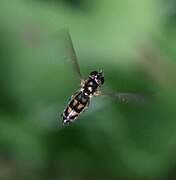Melanostoma scalare
| Melanostoma scalare | |
|---|---|

| |
| male | |

| |
| female | |
| Scientific classification | |
| Kingdom: | |
| Phylum: | |
| Class: | |
| Order: | |
| Family: | |
| Genus: | |
| Species: | M. scalare
|
| Binomial name | |
| Melanostoma scalare (Fabricius, 1794)
| |
| Synonyms | |
Melanostoma scalare is a very common species of hoverfly.[2][3][4][5][6][7]
Taxonomy
The European Melanostoma species are not well understood at present. Van der Goot is the most certain identification work.[8] The male genitalia of M. scalare are figured by Dusek and Laska (1967).[9] Other, more accessible, works are listed below.
Distribution
This species is present in most of Europe, the Near East, North Africa, and the eastern parts of the Afrotropical realm south to Zimbabwe and throughout the Indomalayan realm to New Guinea.[10]
Description
M. scalare can reach a length of 7–10 mm (0.28–0.39 in). These hoverflies have a shining black thorax. The males are longer and slimmer than the females. Also, the male's abdomen is much thinner than that of the female. Further, the yellow markings of the male are roundish or diamond-shaped, while those of the female are triangular patches.
Biology
Little is known of its biology, but it is suspected to be general predator of small insects in leaf litter. Adults fly from April to November and inhabit gardens, meadows, and flowering bushes where they feed. The larvae are aphidiphagous.
Gallery
-
Male hovering
-
Female hovering
-
Pupa
References
- ^ Insecta pro
- ^ Ball, Stuart; Morris, Roger (2013). Britain's Hoverflies: An Introduction to the Hoverflies of Britain. Woodstock, Oxfordshire: Princeton University Press. pp. 296pp. ISBN 978-0-691-15659-0.
- ^ Ball, S.G.; Morris, R.K.A. (2000). Provisional atlas of British hoverflies (Diptera, Syrphidae). Monks Wood, UK: Biological Record Centre. pp. 167 pages. ISBN 1-870393-54-6.
- ^ Morris, Roger K. A. (1999). Hoverflies of Surrey. Surrey Wildlife Trust. p. 244. ISBN 0-9526065-3-4.
- ^ Speight, M.C.D. (2011). "Species accounts of European Syrphidae (Diptera)" (PDF). Syrph the Net, the database of European Syrphidae. 65: 285pp.
- ^ Stubbs, Alan E.; Falk, Steven J (1983). British Hoverflies: An Illustrated Identification Guide (2nd ed.). London: British Entomological and Natural History Society. pp. 253, xvpp. ISBN 1-899935-03-7.
- ^ Van Veen, M.P. (2004). Hoverflies of Northwest Europe, Identification Keys to the Syrphidae (Hardback). Utrecht: KNNV Publishing. p. 254. ISBN 90-5011-199-8.
- ^ Van der Goot,V.S. (1981) De zweefvliegen van Noordwest - Europa en Europees Rusland, in het bijzonder van de Benelux. KNNV, Uitgave no.32: 275pp. Amsterdam.
- ^ Dusek, J. & Laska, P. (1967) Versuch zum aufbau eines Naturlichen Systems mitteleuropaischer Arten der Unterfamilie Syrphinae (Diptera). Acta sc.nat.Brno, 1: 349-390.
- ^ Fauna europaea
External links



